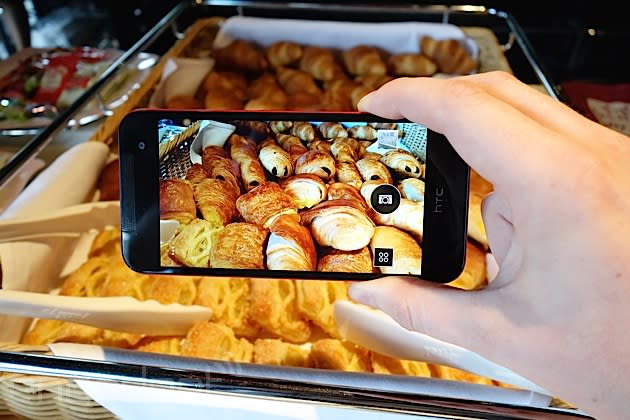Handling HTC's Butterfly 2: the flagship phone you might never see

HTC has its metallic-hewn, well-received One smartphone series. Oh, and its cheaper Desire collection, which has also hit a creative groove of late. But then there's the company's Butterfly phones: high-spec Android devices that rarely make it out of Asia. (We say rarely because one snuck into the US under Verizon: remember the Droid DNA?) Now, in Tokyo, HTC has announced the Butterfly 2 -- the practically-identical, globetrotting version of Japan's HTC J. The company hasn't confirmed whether the model will leave Asia, but it could be a real shame this time around, because going on our early impressions, the Buttterfly 2 could well be better than the HTC One M8. Yeah, we said it.
Let's get the major similarities out of the way -- before we touch on some major changes to the camera. Both 2014's HTC One and the Butterfly 2 (B2) have a full HD 5-inch, Super-LCD and it's still great. There's the same high-end Snapdragon 801 processor, the same flattened, simpler Sense 6 software UI, compatibility with those curious Dot View cases and capacitive Android buttons are now part of the screen -- and there's three of them, like most Google-powered smartphones. Oh, there's still a pair of BoomSound speakers on front too, although this time they're plastic panels almost camouflaged into the black screen.

The differences are found around the back. And the sides. And... the front. Not only is the Butterfy 2 made of a shiny, uniformly curved polycarbonate shell, but the entirety of it is water resistant and IP57-rated. This means it'll survive a 30-minute dip at depths up to 1 meter, but almost as importantly, HTC has ensured its aqua protection forgoes any fiddly flaps to cover up power sockets and such. HTC isn't elaborating whether its rubber seals or a nano-coating that's keeping the phone working.
Alongside similar lines of simplicity, trays for both the nano-SIM and micro-SD card don't require a pin to spring them open: they're now (satisfyingly solid) pull-out trays. Other minor upgrades include an incrementally larger battery (2,700mAh vs. 2,600mAh on this year's One), and a trio of shimmery, bold-colored models to choose from. Well, Blue, Red -- and a White option. (HTC's told Engadget that the white model here has a special stain resistance treatment now, which sounds like a detergent ad, but means it'll stop scratches and mishaps from tainting the white finish). The plastic finish is a divisive one, but in real life, both the red and blue finishes are luminous and quite attractive. For those that liked HTC's metal unibodies, however, you're likely to be a little disappointed. It's difficult to determine whether the phone will be repurposed outside of Asia: for 4G band nerds, it packs FDD bands 1,3,7, 8, 28 and TDD bands 38, 40 and 41. In short, this smartphone doesn't click with any of the major US carriers. At least, not this particular model.

HTC has been pushing its camera skills for a few years. More recently that's involved bowing out of the megapixel-count with a 4-megapixel 'UltraPixel' camera sensor and offering some very impressive low-light performance with it. Well, things have changed on this phone -- and we're not sure what to make of it just yet.
First up, the secondary depth sensor first seen on this year's HTC One is very much here, adding improvements to autofocus speed as well as the ability to add a bit of post-processing magic to your shots based on depth info. But the main shooter itself is no longer an UltraPixel camera -- it's now a 13-megapixel sensor with, we guess, just normal pixels. It's a double-edged sword: HTC's philosophy with the camera sensors in its One series were refined and focused on offering up high performance photos in low light. Pixels were given room to bathe in more light, but that came with a trade-off in the sheer number of pixels. On the front, you'll still get a wide-angled 5-megapixel front-facing sensor to keep that selfie habit going strong.
With the Butterfly 2, HTC has cranked the resolution up substantially on the front-facing camera, meaning you could now crop and zoom, and your photos (if you need it) are simply more detailed, given the wider canvas. During our early tests, the difference in detail is noticeable once you pinch-and-zoom a little. However, we're still waiting to test the Butterfly 2's camera in less favorable lighting settings to see how it handles it. HTC's spokespeople reiterated that it'll continue with its UltraPixel cameras, but that the Butterfly 2 offered a different kind of camera sensor. Fortunately for us, and you, we've taken possession of a review sample. Expect our verdict in the coming weeks.















